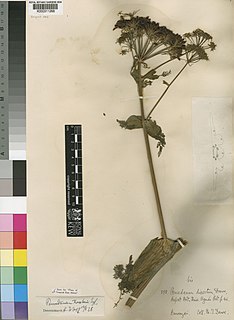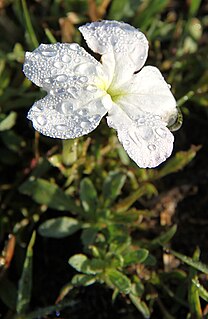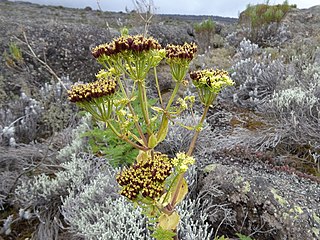
Satureja is a genus of aromatic plants of the family Lamiaceae, related to rosemary and thyme. It is native to North Africa, southern and southeastern Europe, the Middle East, and Central Asia. A few New World species were formerly included in Satureja, but they have all been moved to other genera. Several species are cultivated as culinary herbs called savory, and they have become established in the wild in a few places.

Jasmine is a genus of shrubs and vines in the olive family (Oleaceae). It contains around 200 species native to tropical and warm temperate regions of Eurasia, Africa, and Oceania. Jasmines are widely cultivated for the characteristic fragrance of their flowers. A number of unrelated plants contain the word "jasmine" in their common names.

Dalbergia is a large genus of small to medium-size trees, shrubs and lianas in the pea family, Fabaceae, subfamily Faboideae. It was recently assigned to the informal monophyletic Dalbergia clade : the Dalbergieae. The genus has a wide distribution, native to the tropical regions of Central and South America, Africa, Madagascar and southern Asia.

Bauhinia is a large genus of flowering plants in the subfamily Cercidoideae and tribe Bauhinieae, in the large flowering plant family Fabaceae, with a pantropical distribution. The genus was named after the Bauhin brothers Gaspard and Johann, Swiss-French botanists.

Rapid plant movement encompasses movement in plant structures occurring over a very short period, usually under one second. For example, the Venus flytrap closes its trap in about 100 milliseconds. The traps of Utricularia are much faster, closing in about 0.5 milliseconds. The dogwood bunchberry's flower opens its petals and fires pollen in less than 0.5 milliseconds. The record is currently held by the white mulberry tree, with flower movement taking 25 microseconds, as pollen is catapulted from the stamens at velocities in excess of half the speed of sound—near the theoretical physical limits for movements in plants.

Linnaea is a plant genus in the honeysuckle family Caprifoliaceae. Until 2013, the genus included a single species, Linnaea borealis. In 2013, on the basis of molecular phylogenetic evidence, the genus was expanded to include species formerly placed in Abelia, Diabelia, Dipelta, Kolkwitzia and Vesalea. However, this is rejected by the majority of subsequent scientific literature and flora.

Pluchea is a genus of flowering plants in the tribe Inuleae within the family Asteraceae. Members of this genus might be known as camphorweeds, plucheas, or less uniquely fleabanes. Some, such as P. carolinensis and P. odorata, are called sourbushes. There are plants of many forms, from annual and perennial herbs to shrubs and trees, and there is variation in the morphology of leaves, flowers, and fruits.

Pulicaria is a genus of flowering plant in the sunflower family, native to Europe, Asia, and Africa. In North America Pulicaria is known by the common name false fleabane.

Aeschynomene is a genus of flowering plants in the family Fabaceae, and was recently assigned to the informal monophyletic Dalbergia clade of the Dalbergieae. They are known commonly as jointvetches. These legumes are most common in warm regions and many species are aquatic. The genus as currently circumscribed is paraphyletic and it has been suggested that the subgenus Ochopodium be elevated to a new genus within the Dalbergieae, though other changes will also be required to render the genus monophyletic.

Afrosciadium kerstenii, synonym Peucedanum kerstenii, is a member of the carrot family, Apiaceae. It is native to east tropical Africa and the Democratic Republic of the Congo (Zaïre). It grows among the giant groundsels (Dendrosenecio) atop of the mountains of east Africa: Mount Kilimanjaro, Mount Kenya, Rwenzori Mountains and the Virunga Volcanoes.

Blumea is a genus of flowering plants of the family Asteraceae.

Linnaea floribunda is a species of flowering plant in the honeysuckle family, Caprifoliaceae, native to Mexico. Growing to 4 m (13 ft) tall and broad, it is a semi-evergreen or evergreen shrub with shiny ovate leaves and clusters of tubular cerise flowers to 5 cm (2.0 in) long. Though hardy down to −10 °C (14 °F) it prefers a sheltered location, for instance against a south-facing stone wall.

Cycloclavine is an ergot alkaloid. It was first isolated in 1969 from seeds of Ipomoea hildebrandtii vatke. The first total synthesis of (±)-cycloclavine was published in 2008 by Szántay. Further reports came from Wipf and Petronijevic, Cao and Brewer. In 2016, Wipf and McCabe completed an 8-step asymmetric synthesis of (–)-cycloclavine, and in 2018, they expanded this approach toward (+)-cycloclavine and a biological characterization of the binding profile of both enantiomers on 16 brain receptors. Natural (+)- and unnatural (–)-cycloclavine demonstrated significant stereospecificity and unique binding profiles in comparison to LSD, psilocin, and DMT. Differential 5-HT receptor affinities, as well as novel sigma-1 receptor properties, suggest potential future therapeutic opportunities of clavine alkaloid scaffolds.

Cycnium is a genus of flowering plant in the family Orobanchaceae. Its native range is tropical and southern Africa and Madagascar.

Afrosciadium is a genus of flowering plants belonging to the carrot family, Apiaceae. It was split from the genus Peucedanum in 2008 by P.J.D. Winter, et al.

Afrosciadium harmsianum, synonym Peucedanum harmsianum, is a member of the carrot family, Apiaceae. It is a perennial tuberous herb native to east tropical Africa.

Afrosciadium articulatum, synonym Peucedanum articulatum, is a member of the carrot family, Apiaceae. It is native to northern Malawi.

Afrosciadium caffrum is a member of the carrot family, Apiaceae. It is a perennial tuberous herb native to subtropical regions in eastern South Africa.

Afrosciadium magalismontanum is a member of the carrot family, Apiaceae. It is a perennial tuberous herb native to subtropical regions in eastern South Africa and Eswatini. It has a tall, narrow stem which divides into multiple evenly-spaced branches near the top, with each branch sporting a cluster of small yellow flowers at its end.



















